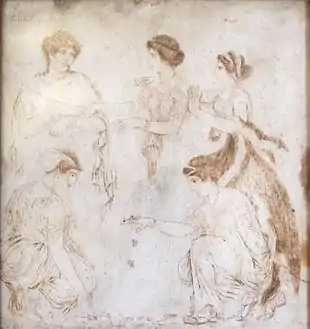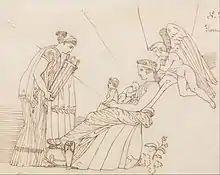Phoebe (Titaness)
In ancient Greek religion and mythology, Phoebe (/ˈfiːbi/ FEE-bee; Ancient Greek: Φοίβη, romanized: Phoíbē, associated with φοῖβος phoîbos, "shining") was one of the first generation of Titans, who were one set of sons and daughters of Uranus and Gaia.[1] She was the grandmother of Apollo and Artemis, and the witchcraft goddess Hecate. According to myth, she was the original owner of the site of the Oracle of Delphi before gifting it to her grandson Apollo. Her name, meaning "bright", was also given to a number of lunar goddesses like Artemis and later the Roman goddesses Luna and Diana, but Phoebe herself was not actively treated as a moon goddess on her own right in ancient mythology.
| Phoebe | |
|---|---|
Goddess of the Oracle of Delphi | |
| Member of the Titans | |
 A fresco of Herculaneum depicting Phoebe trying to pacify Leto and Niobe, while Hilearia and Agle play knucklebones, painted and signed by an artist named "Alexander of Athens", 1st century AD, now in the Museo Archeologico Nazionale (Naples) | |
| Personal information | |
| Parents | Uranus and Gaia |
| Siblings |
|
| Consort | Coeus |
| Offspring | Leto, Asteria |
Etymology
Greek Φοίβη, feminine form of Φοῖβος means "pure, bright".[2][3] Another meaning is "prophet", a reference to her role in myth.[2] Used for water and fire both, it can thus be explained as generally meaning "pure", "clear", or "bright".[4]
Family
Phoebe is a Titaness, one of the twelve (or thirteen) divine children born to Uranus (Sky) and Gaia (Earth). Phoebe's consort was her brother Coeus, with whom she had two daughters, first Leto, who bore Apollo and Artemis, and then Asteria, a star goddess who bore an only daughter, Hecate.[5] Hesiod in the Theogony describes Phoebe as "χρυσοστέφανος" (khrysostéphanos, meaning "golden-crowned").[1]
Mythology

Through Leto, Phoebe was the grandmother of Apollo and Artemis. The names Phoebe and Phoebus (masculine) came to be applied as synonyms for Artemis/Diana and Apollo respectively,[6] as well as for Luna and Sol, the lunar goddess and the solar god, by the Roman poets; the late-antiquity grammarian Servius writes that "Phoebe is Luna, like Phoebus is Sol."[7] Phoebe was, like Artemis, identified by Roman poets with the Roman moon goddess Diana.[8] Phoebe means "bright" but is functionally only a name; in mythology, the role of moon goddess is fulfilled by other deities as her grandchildren inherit her name.[9]

According to a speech that Aeschylus puts into the mouth of the Delphic priestess herself in The Eumenides, Phoebe received control of the Oracle at Delphi from her sister Themis, who herself had received it from their mother Gaia, and then passed it on Apollo, her grandson, as a gift for his birthday:[10] D. S. Robertson noted "Phoebe in this succession seems to be his private invention," reasoning that in the three great allotments of oracular powers at Delphi, corresponding to the three generations of the gods, "Ouranos, as was fitting, gave the oracle to his wife Gaia and Kronos appropriately allotted it to his sister Themis."[11] Robertson also speculates that in Zeus' turn to make the gift, Aeschylus could not report that the oracle was given directly to Apollo, who had not yet been born, and thus Phoebe was interposed.[11] These supposed male delegations of the powers at Delphi as expressed by Aeschylus are not borne out by the usual modern reconstruction of the sacred site's pre-Olympian history.
Phoebe's name appears on the southeast corner of the Pergamon Altar which depicts the Gigantomachy,[12] fighting against a Giant with animal features, similar to the one her daughter Leto is fighting.[13] Phoebe, wearing a diadem and a very creased dress, is seen wielding a flaming torch and fighting next to her other daughter Asteria.[14]
Legacy
Phoebe, one of the moons of Saturn is named after this goddess, as sister of Cronus, Saturn's Greek equivalent. Phoebe (also spelled Phebe) is also a popular feminine given name in the English-speaking world.
Genealogy
Notes
- Hesiod, Theogony 116-138.
- A Greek-English Lexicon s.v. φοῖβος; s.v. φοίβη
- Etymology of φοῖβος in Bailly, Anatole (1935) Le Grand Bailly: Dictionnaire grec-français, Paris: Hachette.
- Beekes, R. S. P., Etymological Dictionary of Greek (Leiden: Brill, 2009), 1:1582.
- Hesiod, Theogony 404–452.
- Compare the relation of the comparatively obscure archaic figure of Pallas and Pallas Athena.
- Servius, Commentary on Virgil's Aeneid 10.216
- Boyle, p. 147
- Gordon MacDonald Kirkwood, A Short Guide to Classical Mythology, p. 88
- Aeschylus, Eumenides 1; Orphic Hymn 79 to Themis (Athanassakis and Wolkow, p. 62).
- Robertson, p. 70.
- Picón and Hemingway, p. 47
- Ridgway, p. 57
- LIMC 617 (Phoebe 1); Honan, p. 21
- Hesiod, Theogony 132–138, 337–411, 453–520, 901–906, 915–920; Caldwell, pp. 8–11, tables 11–14.
- Although usually the daughter of Hyperion and Theia, as in Hesiod, Theogony 371–374, in the Homeric Hymn to Hermes (4), 99–100, Selene is instead made the daughter of Pallas the son of Megamedes.
- According to Hesiod, Theogony 507–511, Clymene, one of the Oceanids, the daughters of Oceanus and Tethys, at Hesiod, Theogony 351, was the mother by Iapetus of Atlas, Menoetius, Prometheus, and Epimetheus, while according to Apollodorus, 1.2.3, another Oceanid, Asia was their mother by Iapetus.
- According to Plato, Critias, 113d–114a, Atlas was the son of Poseidon and the mortal Cleito.
- In Aeschylus, Prometheus Bound 18, 211, 873 (Sommerstein, pp. 444–445 n. 2, 446–447 n. 24, 538–539 n. 113) Prometheus is made to be the son of Themis.
References
- Aeschylus, Eumenides in Aeschylus, with an English translation by Herbert Weir Smyth, Ph.D. in two volumes. 2. Eumenides. Herbert Weir Smyth, Ph.D. Cambridge, MA. Harvard University Press. 1926.
- Aeschylus, Persians. Seven against Thebes. Suppliants. Prometheus Bound. Edited and translated by Alan H. Sommerstein. Loeb Classical Library No. 145. Cambridge, Massachusetts: Harvard University Press, 2009. ISBN 978-0-674-99627-4. Online version at Harvard University Press.
- Athanassakis, Apostolos N., and Benjamin M. Wolkow, The Orphic Hymns, Johns Hopkins University Press; owlerirst Printing edition (May 29, 2013). ISBN 978-1-4214-0882-8. Google Books.
- Apollodorus, Apollodorus, The Library, with an English Translation by Sir James George Frazer, F.B.A., F.R.S. in 2 Volumes. Cambridge, Massachusetts, Harvard University Press; London, William Heinemann Ltd. 1921. Online version at the Perseus Digital Library.
- Boyle, A. J. (editor), Seneca: Medea: Edited with Introduction, Translation, and Commentary, OUP Oxford, 2014. ISBN 9780199602087.
- Caldwell, Richard, Hesiod's Theogony, Focus Publishing/R. Pullins Company (June 1, 1987). ISBN 978-0-941051-00-2.
- Hesiod, Theogony, in The Homeric Hymns and Homerica with an English Translation by Hugh G. Evelyn-White, Cambridge, Massachusetts., Harvard University Press; London, William Heinemann Ltd. 1914. Online version at the Perseus Digital Library.
- Homeric Hymn to Hermes (4), in The Homeric Hymns and Homerica with an English Translation by Hugh G. Evelyn-White, Cambridge, Massachusetts., Harvard University Press; London, William Heinemann Ltd. 1914. Online version at the Perseus Digital Library.
- Honan, Mary McMahon, Guide to the Pergamon Museum, De Gruyter, 1904. ISBN 9783112399330. Online version at De Gruyter.
- Maurus Servius Honoratus, In Vergilii carmina comentarii. Servii Grammatici qui feruntur in Vergilii carmina commentarii; recensuerunt Georgius Thilo et Hermannus Hagen. Georgius Thilo. Leipzig. B. G. Teubner. 1881. Online version at the Topos Text.
- Picón, Carlos A.; Hemingway, Seán, Pergamon and the Hellenistic Kingdoms of the Ancient World, Yale University Press, 2016, ISBN 978-1-58839-587-0.
- Ridgway, Brunilde Sismondo, Hellenistic Sculpture II: The Styles of ca. 200–100 B.C., The University of Wisconsin Press, 2000.
- Robertson, D.S., "The Delphian Succession in the Opening of the Eumenides" The Classical Review 55.2 (September 1941, pp. 69–70). JSTOR 703888.